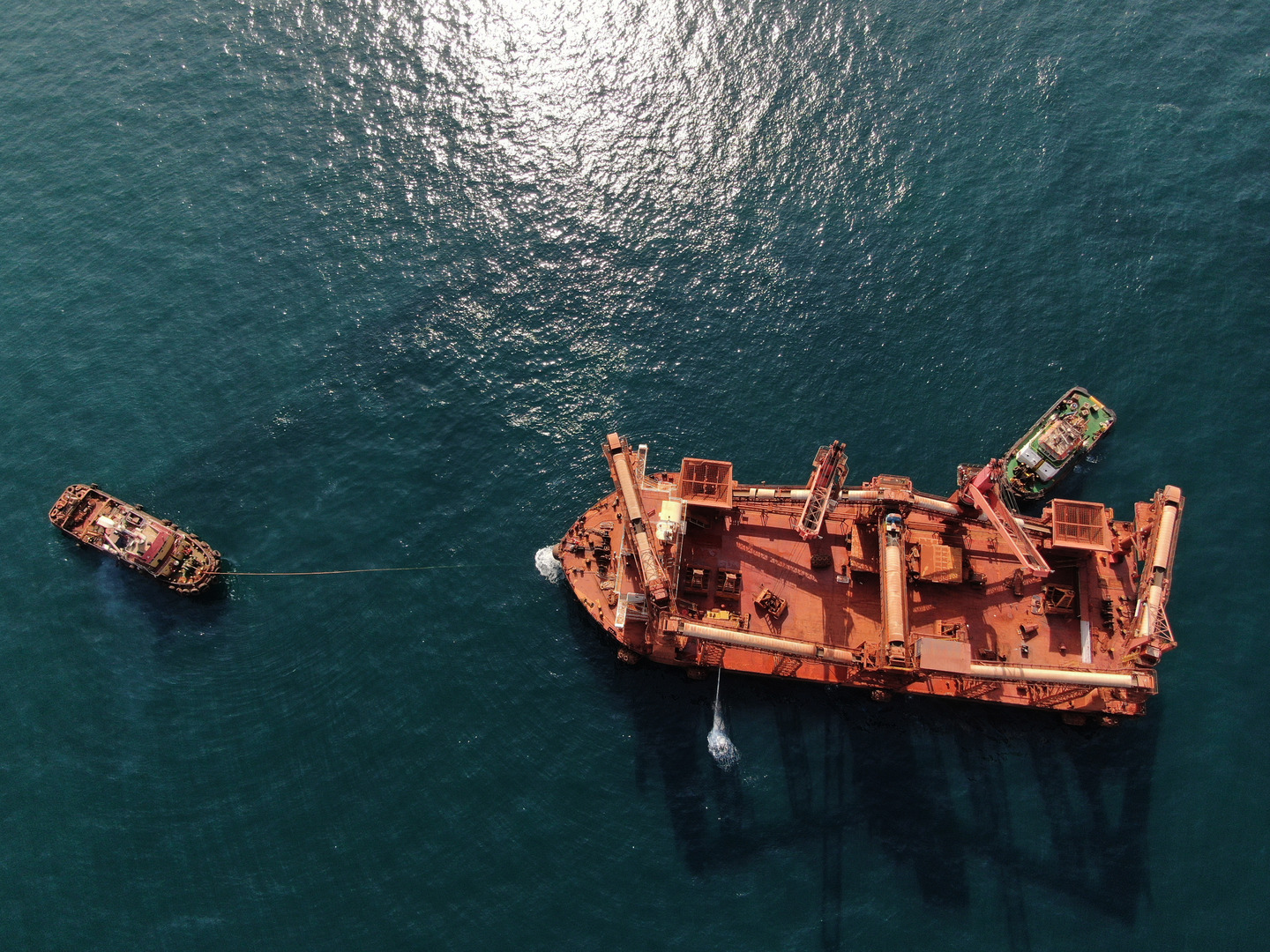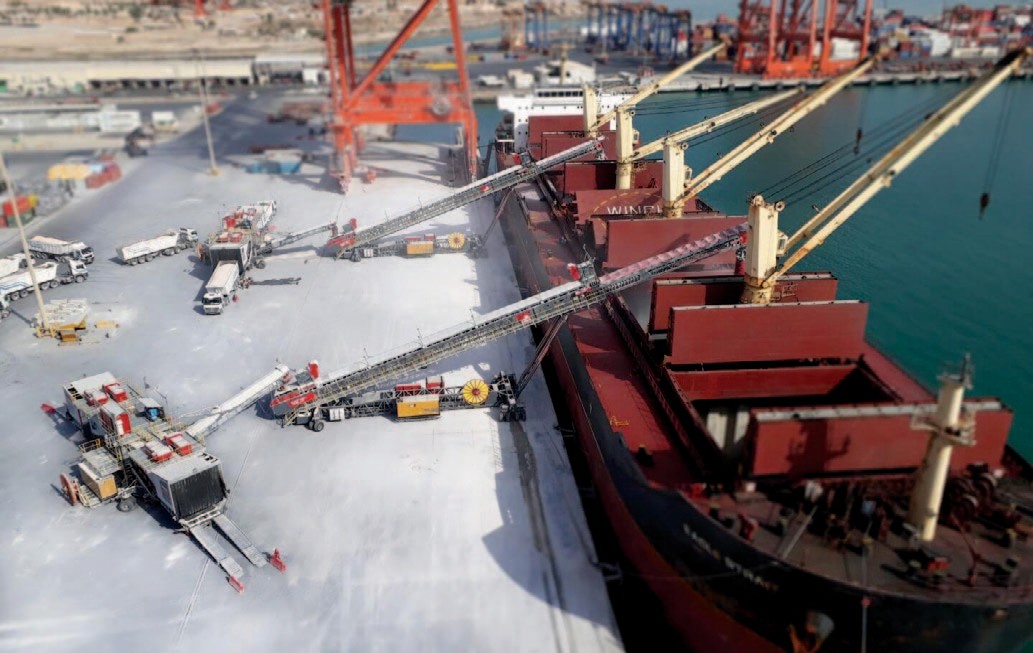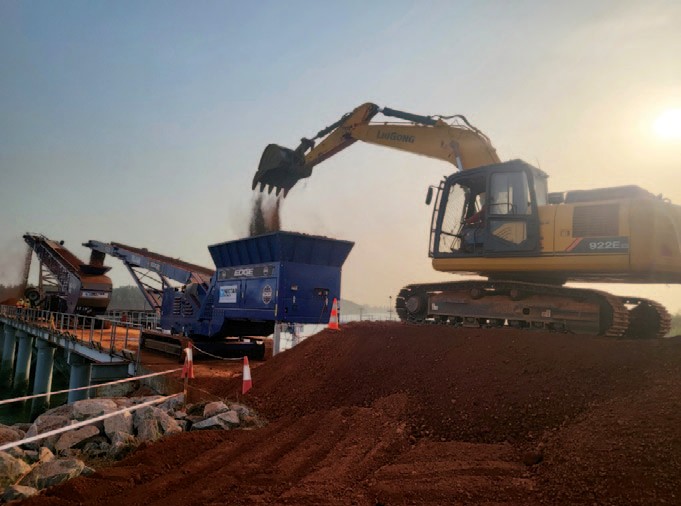A portable shiploader in operation to load the vessel (source: Internet).
The periphery of the maritime and logistics industry continues to expand along with the need to offer flexible, efficient, and successful operational solutions. Some ports and harbours are fully equipped with their bulk handling system or equipment. Meanwhile, project locations where port or harbour facilities are limited, or unavailable, could cost owners time and investment in building up the facilities necessary for the project. An ideal solution in such cases would be to deploy a mobile bulk handling system to overcome these limitations.
In general, bulk handling systems are responsible for the loading, unloading, storage, and transfer of cargo during the first mile, middle mile, and end-mile delivery. Comprising equipment such as cranes, shiploaders, conveyors, hoppers, etc., bulk handling systems can either be of the fixed type or the mobile type. The success rate of a project is directly proportional to the smart handling of cargo. Hence, choosing an efficient system to handle the cargo is a determinant factor for a profitable output. Some primary factors that aid in the selection are:
- location of installation;
- type and amount of cargo to be handled;
- permissible vessel size in the project location; and
- duration of the project.
The two types of bulk handling systems — fixed and mobile — come with their advantages and drawbacks depending on the conditions of the project. The table below shows some of the advantages and disadvantages of the two systems:
CASE STUDY
Shi.E.L.D. Services is currently involved in the selection of suitable bulk-handling systems for one of its valuable clients based on their project targets. The company’s expertise has been invaluable, as shown in the below breakdown of the project.
COMPARISON BETWEEN FIXED AND MOBILE BULK HANDLING SYSTEMS
Mobile bulk handling systems
- Usable for both short-term and long-term operations Modular design: modules can be added to the system to increase flexibility
- Available as a series of models from the makers hence saving construction time.
- No civil construction and ready to be installed upon delivery Less customizable due to factory design
- Comparatively lower capital investments.
- Can be relocated when necessary. Hence, increased mobility and flexibility
- The amount of cargo to be handled is limited to the factory design
Fixed bulk handling systems
- Usable for long-term operations
- Fixed design and structure limit the addition of components or modules
- Time consumed is longer during construction & erection
- Requires planning permissions and civil construction Customizable as per the project needs
- A higher initial investment in construction, labour, & tests. Operated only at the installed location
- Can handle large amounts of cargo
The client targets transporting cargo from the quarry located strategically in the vicinity of a river. The strategic location of the quarry directed the client to construct a new jetty for the cargo to be loaded onto a barge(s), which then will navigate to the OGV (oceangoing vessel) in the offshore transshipment area. With the data obtained on the jetty design, physical layout, designated transshipment location, and desired target from the client, Shi.E.L.D. Services performed a preliminary study to evaluate the loading facilities and an operational plan.
To achieve the client’s desired target in the decided time interval with the lowest possible initial investment, Shi.E.L.D. Services guided its client to deploy a mobile shiploader at the newly constructed jetty. The study reveals that the time available for the commencement of the operation is limited, and the construction of a fixed bulk handling system is not feasible.
A mobile shiploading system comprised of hopper feeders and a radial telescopic shiploader will be deployed to create a flow of cargo transfer onto the barge. The hopper feeder will then be loaded with the cargo by the wheel loaders from either side and a truck from the rear side. This makes it possible for the hopper feeder to be loaded from all three sides, potentially keeping up the maximum loading rate. The cargo from the hopper feeder is then fed into the shiploader which is directed toward the barge.
Shi.E.L.D. Services choice to deploy a mobile shiploader has proven to be time- saving and cost-efficient for the client, due to the ideal suitability of the mobile system to the project requirements. The latter should be an important consideration in the assessment of deploying a mobile shiploading system.
A few other factors that make the mobile shiploader more suitable for this project are:
A portable bulk handling system equipped with a track loader, hopper feeder, and shiploader loading a barge (source: Internet).
- shorter delivery time;
- lower initial capital costs;
- self-sustained equipment as it can be provided with an onboard power generation unit;
- relocation of the equipment is possible when necessary; and
- the modular and pre-assembled design makes it possible to add or remove additional units as required by the loading rate.
Adopting the mobile ship loading system allows Shi.E.L.D. Services’ client to actively perform operations in a short interval of time. This is highly advantageous and makes it possible to be competitive in the dynamic and demanding market. With this efficient system, there is a significant improvement in the client’s ability to produce profitable turnover with lower capital investment. Overall, it may be said that projects that confront operational restrictions due to the absence of a bulk handling system and the time constraint in constructing one, can enjoy the versatility of the mobile system to be resourceful, operative, and achieve the best project rate.



